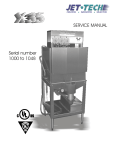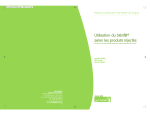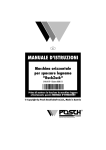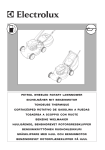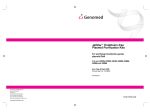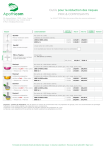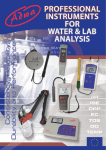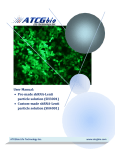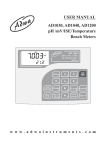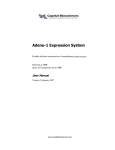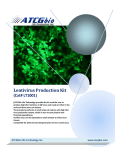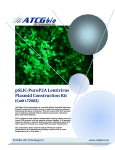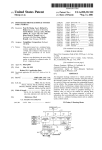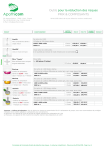Download User Manual PDF - ATCGbio Life Technology
Transcript
Adeno-Purification Kits (AD1001, AD1002& AD1003) ATCGBIO LIFE TECHNOLOGY INC Welcome to the Next Level of Adenovirus Purification Adeno-‐Purification Kits User manual AD1001 AdenoComplete Purification Kit 3 preps AD1002 AdenoComplete Purification Kit 3 preps with Adeno-‐GFP AD1003 AdenoEssential Purification Kit 9 preps Version: 1.1 ATCGbio LIFE TECHNOLOGY INC. http://www.atcgbio.com http://www.atcgbio.com Page 0 Adeno-Purification Kits (AD1001, AD1002& AD1003) ATCGbio LIFE TECHNOLOGY INC. Content Introduction ...................................................................................................................... 2 Products and Related Products .................................................................................. 3 Kits Components .............................................................................................................................. 3 Materials and Equipments Users Provide ............................................................... 3 Adenovirus Amplification in HEK 293 Cells ........................................................... 4 Steps at-‐a-‐glance .............................................................................................................. 5 Safety Precautions ........................................................................................................... 6 Ø Notice for first-‐time user ........................................................................................................... 6 Detailed Protocol ............................................................................................................. 7 Regeneration of the Binding Filter ............................................................................ 8 Viral Titration ................................................................................................................... 8 Terminology for Adenovirus Work ........................................................................... 9 Ø Examples for viral titration by using our kits ................................................................ 9 Usage of AdenoBooster Solution ............................................................................. 10 Table1. Approximate Cells Yield ............................................................................. 10 References ...................................................................................................................... 11 Contact Information .................................................................................................... 11 FOR RESEARCH USE ONLY Not for use in clinical or diagnosis purpose Important Notice: Even the recombinant adenoviruses are replication deficient by deletions in the E1 and E3 regions, recombinant human adenovirus has been classified in biosafety level II for agents considered of ordinary potential harm, and you need BL-2 level facility to work with it according to references issued by the NIH Office of Biosafety. It should be noted that cell culture facilities in most institutes are certified as BL-2 level. Wild type, replication competent adenoviruses could cause cold symptoms but generally do not cause serious illness. For more information on biosafety levels please visit http://oba.od.nih.gov http://www.atcgbio.com Page 1 Adeno-Purification Kits (AD1001, AD1002& AD1003) ATCGbio LIFE TECHNOLOGY INC. Introduction Thank you for purchasing ATCGbio products. Adeno-Purification Kits are achievements of our scientists 10 years’ experience and more than 5 years’ researches. We proudly present and share our kits with you. For a new user the kits could be used as the training kits to help the researchers understanding procedure of adenovirus amplification and purification. The kits have following features standing in the top of the adenovirus purification methods currently available. 1. Obtain High quality adenovirus in 1.5 hour based on membrane filtration. The procedure does not require ultracentrifugation. 2. Typically, it only requires HEK293 cell culture in 4 of 10 cm dishes or T75 flasks (can be scaledup to 9 dishes or flasks) to yield adenovirus up to 1.0 × 1011 pfu. in 2 ml volume. 3. Supplied Stabilizer provides an unprecedented stability by virtually eliminating freeze/thaw degradation problem up to 10 times. 4. upplied AdenoBooster Solution (AD1012) could increase the infection efficiency (up to 50 times more) for the cells lacking of coxsackie/adenovirus receptor (CAR) or the cells having difficult infection characters. 5. The kits provide enough reagents for 3-times (AdenoComplete, AD1001 & AD1002) and 9-times (AdenoEssential, AD1003 ) purification. 6. In AdenoComplete (AD1002), we provide crude Adeno-GFP expression vector as a positive control. 7. In-vivo compatibility. The injection of adenoviruses purified by our kits to mouse through the tail vein shows the efficient transduction in the liver without apparent immunoreactions. 8. Very economical. We set up the most cost-effective way to purify adenovirus without compromising performances. 9. Detailed protocol describes the safe preparation and usage. http://www.atcgbio.com Page 2 Adeno-Purification Kits (AD1001, AD1002& AD1003) ATCGbio LIFE TECHNOLOGY INC. Products and Related Products #AD1001 AD1001 AD1002 AD1003 AD1011 AD1012 AdenoCompletePurification PurificationKit Kit AdenoComplete AdenoComplete Purification Kit with Adeno-GFP AdenoEssential Purification Kit AdenoRetriever Solution AdenoBooster Solution AD1020 Crude Adeno-GFP Expression Vector AD1030 Crude Adeno-ß-Galactosidase Expression Vector 3 xpreps preps 3x 3x preps 9 x preps. 500µl/vial 500µl/vial 500µl/vial 1.0 x 109 pfu/ml 500µl/vial, 1.0 x 109 pfu/ml Kits Components Catalog AdenoComplete (AD1001&AD1002*) AdenoEssential (AD1003) AD1001-01 Blunt needle × 3 Blunt needle × 9 AD1001-02 Binding filter × 1 Binding filter × 3 AD1001-03 30ml Loading Buffer × 1 100ml Loading Buffer × 1 AD1001-04** 60ml Washing Buffer × 1 5× concentrated 60ml Washing Buffer × 1 AD1001-04-5** AD1001-05 15ml Elution Buffer × 1 60 ml Elution Buffer × 1 AD1001-06 1.5ml Stabilizer Solution × 1, keep at 4°C 1.5ml Stabilizer Solution × 2, keep at 4°C AD1012 0.5ml Booster Solution × 1, keep at 4°C 1.5 ml Booster Solution × 1, keep at 4°C * For product AD1002, the kit supplied with Crude Adeno-GFP expression vector in 2ml tube, and shipped at room temperature, store at -20°C once received ** Catalog number AD1001-04 is for 1× Washing Buffer, Catalog number AD1001-04-5 is for 5× concentrated Washing Buffer. Materials and Equipments Users Provide • • • • • • • • • • • • • • • • • Stericup-GV 0.22µm 150ml (cat#SCGVU01RE from Millipore, ~$7.00 each) Disposable Luer-Lock syringe: 20ml, 10ml and 3ml such as BD 309661, BD 309604 and BD 309585. (For safety reason, Luer-Lock syringe should be used) 7.5% NaHCO3: such as Invitrogen 25080-094 (may need to adjust pH) 50ml sterile tube: to collect crude adenovirus 15ml sterile tube: to collect purified adenovirus Centrifuge machine 2000 rpm accommodating 50 ml tube Water bath 30°C or 37 °C Bleach: 10% Bleach solution diluted concentrated bleach with water 500ml beaker (to trash used materials and treat with bleach inside) Decant bottle: The bottle is for collect medium after virus binding. § 50 ml tube also can be used instead of the bottle. Biosafety cabinet (Class II) ~200 ml Sterile water (for AdenoEssential kits). Spectrophotometer capable to measure OD260 0.1% SDS dissolved in Dulbecco’s PBS (DPBS) or TE buffer 0.5N NaOH 10ml for regeneration of the binding filter 1N NaOH solution: If DMEM with 25mM HEPES is used to culture 293 cells 20% Ethanol in DPBS (Add 40ml DPBS to 10ml 100% ethanol) http://www.atcgbio.com Page 3 Adeno-Purification Kits (AD1001, AD1002& AD1003) ATCGbio LIFE TECHNOLOGY INC. Adenovirus Amplification in HEK 293 Cells Getting high titer adenovirus depends on HEK293 cells condition. We recommend to culture HEK293 cells with 10% FBS (FCS) + high glucose (4.5 g/L) DMEM under 5-10% CO2 at 37 °C in 10cm dishes or T-75 flask. If user use DMEM containing 25mM HEPES, 1N NaOH would be added during purification procedures (describe later). Healthy HEK293 cells exhibit flat epithelium morphology as shown below. Prepare one seeding plate (a plate for splitting). Once it grows to 80-90% confluence, split it to 5 of 10cm dishes equally with each 10ml medium (one for seeding and others for amplification). Typically, it is not necessary to change medium until the cells reach 80-90% confluence. After the cells reach about 90% confluence, it’s ready for amplification. Place 10 ml fresh medium and infect the cells with 5-10 MOI of adenovirus. If you don’t know the viral titer, you should first determine the virus amount that cause the cytopathic effect (CPE*) in one well of 6-well plate (90% conference). Appropriate amount of the virus should cause the CPE in 3-5 days. Then, use 6-times more virus for one 10cm dish. For example, if 10µl of your virus can cause your HEK293 cells appearing CPE in one well of 6-well plate, you need 60µl of your virus for each 10cm dish. Notice: Do not use too much high titer adenovirus to infect the cells (e.g. all the HEK293 cells float just in 1 or 2 days after infection). Once you add adenovirus you should not change medium. Very important: During course of amplification, if the medium color becomes yellow (indication of lower pH), add 50-100 µl of 7.5% NaHCO3 solution (such as Invitrogen 25080-094) to correct pH until the medium color turns to just light purple. If there is no sign of the CPE in your HEK 293 cells after 5 days, add 1or 2 ml fresh medium and keep incubating. When the most of HEK 293 cells float (about 90%), collect all medium and cells together (about 40-50 ml) into 50ml sterile plastic centrifuge tube (such as Corning 4558 or Falcon 352070). Keep the tube at – 80°C or – 20°C and keep it in standing position (to avoid accidental leak during freezing) until it’s ready to be purified by the kit. It is possible to keep the solution for a month or more without titer losing. Once it is ready, please follow the adenovirus purification protocol described in page 7. Healthy HEK 293 cells. 70-80% confluence. Cytopathic effects after the infection of adenovirus (the cells round up and cell edge looks shiny). *The cytopathic effect (CPE) refers to the morphological changes that the cells undergo after infection. Infected cells typically remain intact, but round up and may detach from the dish individually or in “grape-like” clusters that float in the medium. http://www.atcgbio.com Page 4 Adeno-Purification Kits (AD1001, AD1002& AD1003) ATCGbio LIFE TECHNOLOGY INC. Steps at-‐a-‐glance (the detailed protocol at page 9) 1. 2. 3. 4. 5. 6. 7. 8. 9. 10. 11. 12. Thaw and freeze-thaw: two times thaw and one time freeze Centrifuge 5 min at 2000 rpm (500-1000 × g at room temperature) to precipitate debris. Filtrate adenovirus containing medium through a filtration unit. Add the Loading Buffer with 1/10th volume of filtered medium contain adenovirus (e.g. add 4ml, if the medium volume becomes 40ml after filtration). Precondition the binding filter with 3-4ml 1x washing buffer (for AdenoEssential Kit users, first dilute x5 washing buffer 4 ml with 16 ml sterile water in 50 ml conical tube). Filtrate medium containing adenovirus through the binding filter using 20ml Luer-lock syringe. Adenovirus will be bound to the binding filter. Wash the binding filter with 15ml 1x washing buffer. Elute purified adenovirus by applying 2ml elution buffer. Add the Stabilizer Solution with 1/10th amount of purified adenovirus (about 200µl) Measure the absorbance at 260nm to estimate virus titer. Aliquot out adenovirus to proper vials and store them at -80°C. If necessary, use AdenoBooster Solution (cat# AD1012) just before infecting the cells. http://www.atcgbio.com Page 5 Adeno-Purification Kits (AD1001, AD1002& AD1003) ATCGbio LIFE TECHNOLOGY INC. Safety Precautions 1. 2. 3. 4. Use personnel protection equipment: Lab-coat, gloves and safety glasses. Always open the adenovirus container inside a safety cabinet. Kill adenovirus with concentrated or 10% bleach. Do work in the biosafety level 2 facility regulated by the NIH Office of Biosafety* and Canadian Laboratory Biosafety Guideline. 5. Follow regulations set by your institute. Ø Notice for first-‐time user The kit uses Luer-lock syringe to withdraw virus solution and buffers into the syringe and apply the solution through the filters. If you are not familiar with Luer-lock syringe, it is better to practice just before purification, using 20ml syringe and a blunt needle supplied with kit. To attach syringe, take syringe by the right hand and twist it clockwise, and to detach syringe twist it anticlockwise. Attaching blunt needle 1. 2. 3. 4. Remove a gray cap from the needle holder. Take a needle with left hand and a syringe with right hand. Attaching each other and twist syringe clockwise. Pull syringe from needle holder. Detaching blunt needle 1. Take a needle holder with left hand and a syringe with right hand. 2. Put need holder onto needle. 3. Twist syringe anti-clockwise. FOR RESEARCH USE ONLY Not for use in clinical or diagnosis purpose *Important Notice: Even the recombinant adenoviruses are replication deficient by deletions in the E1 and E3 regions, recombinant human adenovirus has been classified in biosafety level II for agents considered of ordinary potential harm, and you need BL-2 level facility to work with it according to references issued by the NIH Office of Biosafety. It should be noted that cell culture facilities in most institutes are certified as BL-2 level. Wild type, replication competent adenoviruses could cause cold symptoms but generally do not cause serious illness. For more information on biosafety levels please visit http://oba.od.nih.gov http://www.atcgbio.com Page 6 Adeno-Purification Kits (AD1001, AD1002& AD1003) Detailed Protocol Before processing purification, please read carefully the following protocol first. 1. Take out the adenovirus tube from -80°C or -20 °C. Make sure the lid is capped tightly. 2. Thaw in 30 °C or 37 °C water bath. If 37 °C water bath is used, take out immediately before the ice is completely melted (Fig.1). Notice: Do not leave in 37 °C for a long time. Tighten the lid again. Do not vortex. 3. Freeze the tube by putting at -80°C for 20 min. 4. Thaw again in water bath like step 2 (Fig.1). 5. Centrifuge at 2000 rpm for 5 min at room temperature. 6. Bring all the materials inside a biosafety cabinet (Fig.2). 7. Connect the vacuum with the vacuum filter unit (Stericup-GV 0.22µm 150 ml). Estimate volume of the adenovirus solution you plan to purify (will be 40 - 90ml). Apply adenovirus solution to the center of the filter. 8. Use a 5ml sterile pipette, add the Loading Buffer into the filtered adenovirus solution. The amount of Loading Buffer you add is 1/10th. volume of the estimated adenovirus solution in step 7 (e.g. if the estimated adenovirus solution is 40ml, add 4ml loading buffer). The solution color should turn red to purple. If the DMEM with 25mM HEPES is used in HEK293 cell culture, add also 1/100th. of 1N NaOH to bring up pH (e.g. 0.4 ml of 1N NaOH to 40 ml filtered solution). 9. Condition the Binding Filter. In case of AdenoComplete user, transfer 20 ml Washing Buffer into 50ml-tube (sterilized). In case of AdenoEssential user, dilute 4 ml of 5× Washing Buffer with 16 ml sterile water. Take 2-3 ml Washing Buffer directly into 10ml syringe (Don’t need to use a needle) and attach the Binding Filter. Push the solution through the filter into a decant bottle (Fig.3). 10. Detach the syringe from the filter and attach a blunt needle. 11. Withdraw the adenovirus solution into the 10 ml syringe (Fig.4). 12. Detach the blunt needle, attach the Banding Filter and push the adenovirus solution through the filter (Fig.5) at a rate about 1-3 drops per second (virus will bind to the binding filter). Speed is not so critical. Repeat until all the adenovirus solution passed through. Trash the 10 ml syringe and the needle into a beaker. 13. Withdraw remaining (~17 ml) washing buffer into a 20 ml syringe. Push the washing buffer through the binding filter at a rate of 1-3 drops per a second. Once again, speed is not critical. (Fig.6, next page) http://www.atcgbio.com ATCGBIO LIFE TECHNOLOGY INC Fig.1 Fig.2 Fig.3 Fig.4 Fig.5 Page 7 Adeno-Purification Kits (AD1001, AD1002& AD1003) 14. To elute the purified adenovirus from the binding filter, use a ATCGbio LIFE TECHNOLOGY INC. 15ml tube (sterilized) and place the binding filter on the top of the tube. Take 2ml of the elution buffer into a 3ml syringe. Push the elution buffer through the binding filter at a rate of 1-2 drops per second (Need to be slow, Fig.7). Stop after 1 ml buffer is through, and wait for 5 min, then finish the rest of the solution. Take air into the syringe and push the air through the filter to complete the elution. 15. Add 1/10th of the Stabilizer solution (0.2-0.25 ml), and aliquot it (typically 300 µl each) into the sterile vials you like and keep them at -80 °C until use. 16. Estimate virus titer and regenerate the Binding Filter. 17. Finishing up: Add concentrated bleach into a decant bottle to kill any remaining viruses by waiting for 10 min. Treat used materials in the beaker with 10% bleach. Dispose all the materials into biosafety bin, and throw bleach treated solution into a sink. Wipe with 10% bleach inside a cabinet, wait for 10 min and clean the cabinet. Fig.6 Fig.7 Regeneration of the Binding Filter The binding filter can be used three times without losing its performance. 1. Use a 3 ml syringe to take 3 ml the elution buffer and push through the binding filter. 2. Change syringe and take 3 ml 0.5N NaOH and push through 1.5 ml and wait for 5 min, then push the remains through the filter. 3. Change syringe and take 3 ml sterile DPBS and push through the filter. 4. Take 3 ml 20% ethanol in sterile DPBS and push through the filter. Eliminate residual solution by pushing air. Put the filter into a clean plastic bag and seal it, and keep it at room temperature until use it again. Viral Titration The virus titer prepared by our kit can be estimated with a spectrophotometer or a Nanodrop by measuring OD260. Dilute purified adenovirus solution 20 times with 0.1% SDS (sodium dodecyl sulfate) dissolved in DPBS or TE to the volume your spectrophotometer can read. For example, if the machine can measure a volume of 100µl, take 5µl virus solution and dilute with 95µl 0.1% SDS solution, and use 5µl elution solution + 95µl SDS as a blank control. Measure them at absorbance 260 nm. By using SDS, virus became inactive and it can be disposed without further treatment. Calculate OD260 = OD (virus) – OD (blank). We typically get the number between 0.050-0.200. Estimated virus titer (pfu/ml): Calculate OD260 × Dilution Factor × 2 × 1010 (pfu/ml). For example, if OD = 0.100, the titer is 0.100 × 20 × 2 × 1010 = 4.0 × 1010 pfu/ml http://www.ATCGbio.com Page 8 Adeno-Purification Kits (AD1001, AD1002& AD1003) ATCGbio LIFE TECHNOLOGY INC. Terminology for Adenovirus Work Pfu or Ifu: The plaque-forming unit (pfu) is the number of viral particles’ capability to form the plaques (the area of cell lysis by per viral particle). It is a functional assessment rather than the absolute quantification of viral particle numbers: viral particles that are defective or which fail to infect their target cells will not produce a plaque and thus it will not be counted. For example, a solution of adenovirus with the concentration of 1,000 pfu/µl means that there are 1,000 infectious viral particles in one microliter of the solution. In case of adenovirus, the procedure for quantified pfu takes 3 weeks in HEK 293 cells. Ifu (infectious unit) can also be used instead of pfu. Ideally, both give the same number. Current popular method to estimate this number is to count the HEK 293 cells number expressing polyhedron protein (adenovirus envelop) after infection. Estimated Pfu or Ifu from OD260: Using the virus prepared by a traditional centrifugation method, Challberg and Ketner reported that pfu can be estimated directly from OD260 by the formula pfu/ml = 9 OD260 × dilution factor × 3.5 × 10 . However, adenovirus prepared by our kit has much higher quality than 10 those and the formula determined empirically is close to OD260 × dilution factor × 2 × 10 (pfu/ml). MOI (Multiplicity of Infection). It is the ratio of number of virus to the number of the cell. An MOI of 10 indicates that there are 10 transduction units (functional virus, pfu or ifu) for every cell in the well. It is important to note that different cell types require different MOIs for successful infection. In addition, because actual transduction (infection) occurs through statistical processes, even in completely permissive cells like HEK 293 cells, MOI =1 produces only 63% infection, and MOI=5 is required for 99% transduction. Ø Examples for viral titration by using our kits Recombinant adenovirus is a choice to express proteins, shRNAs and microRNAs. Since promoter activity could be variable depending on cell types, and expressed products (RNA and protein) may be unstable, expression levels are not only determined by the adenovirus titer. Therefore, it is difficult to describe a protocol work in every situation. Followings are guidelines when you want to expresse proteins in cultured human or rodent cells. Calculation is based on our empirical data. * Example 1* We have purified adenovirus by our kit and measured OD260 = 0.100. Using a formula described previous section (pfu/ml = OD260 × dilution factor × 2 × 1010). Estimated titer is 0.1 × 20 × 2 ×1010 = 4 × 1010 pfu/ml = 4 × 107 pfu/µl. Human endothelial cells are growing confluent in a 12 well plate. We want infect almost all the cells with moderate expression levels. First, estimate the number of the cells in one well of 12 well plate. Number of cells growing in a well of 12 well plate is about 106 cells (See the table1 in page 14). Although this may not be exact, it is close enough). Second, calculate MOI for the cells you use. Required MOI for your cells usually differs from HEK 293 cells. For HEK 293 cells, MOI=5 should infect most of the cells at least with one virus. It is good estimate to use MOI 25 for human cells and MOI 125 with AdenoBooster Solution for the cells from other species. Third, calculate amount of adenovirus per well. According to the cell number in one well and MOI, it should be 25 (MOI) × 1 × 106(cell number/ well) =2.5 × 107 pfu (the number of functional virus) /well. Since virus titer is 4 × 107 pfu/µl, (2.5 × 107 pfu/well)/ (4 × 107 pfu/µl) = 0.625 µl virus solution / well is http://www.ATCGbio.com Page 9 Adeno-Purification Kits (AD1001, AD1002& AD1003) ATCGbio LIFE TECHNOLOGY INC. needed. Because the actual protein expression and titer may vary, test ½ to 2 folds range of adenovirus. It will be 0.3, 0.6, 1.2 µl of the virus each well with 1 ml fresh normal culture medium. If the adding viral amount is too small to pipette, dilute 10 times with DPBS. Incubate the cells with virus for overnight and change the fresh medium next day. Check protein expression after 48-72 hours by western blot and/or by immunochemistry and determine desired adenovirus amounts. Since repeated freeze/thaw cycle has virtually no effects on virus titer prepared by our kit, you can use this number for later experiments as far as you keep -80°C after each use. * Example 2 * The same virus is used to infect mouse C2C12 cells cultured in the 6 well plate. Estimated the cell number is approximately 2.5 ×106 per well (see table 1). MOI should be 125 and infecting with AdenoBooster Solution. So, 125 × 2.5 × 106(pfu/well) = 312.5 × 106 = 31 × 107(pfu/well). Since virus titer is 4 × 107 pfu/µl, amount of virus is 31/4 = 7.8 µl/well. One well requires approximately 8 µl virus + 0.8 µl AdenoBooster. * How to write in your paper? * You can report either in MOI or in Pfu. In case of Example 1, 25 MOI or 5 × 107 per well or ml or 50 pfu/cell were infected. Usage of AdenoBooster Solution Not every type of the cell requires the AdenoBooster Solution (AD1012). The cells lacking of coxsackie/adenovirus receptor (CAR) are refractory for adenovirus infection. For these cells, we provide the AdenoBooster Solution that is able to enhance the infection efficiency by 10-50 folds. The solution has no effects on permissive cells like HEK 293 cells though without any toxicity. In our tests, human cells usually do not require the solution, but most of rodent cells (except adult cardiomyocytes) and bovine cells require this solution. The solution mixture with adenovirus also could be used for in vivo injection to mice. Usage: Add 1/10th AdenoBooster Solution to adenovirus solution prepared by our kit (Note: just before use). For example, adding 1µl AdenoBooster solution to 10 µl of virus solution and incubate at RT for 5-10 min just before infection. If the virus amount is less than 10 µl, dilute 10 times of AdenoBooster Solution with sterile DPBS just before infection, and add 1:1 ratio of AdenoBooster solution: virus solution. For your convenience, we also offer reporter crude adenoviruses expression vectors such as ß-Galactosidase (AD1030) or GFP (AD1020) to evaluate infection efficiency in your target cells. Table1. Approximate Cells Yield This table provides approximate cell number in various plates and flasks. If you don’t know the cell number to be infected, use this table. Plate Number of the cells/well Plate/Flask 24 well 5.0×105 60mm 5.2 × 106 12 well 1.0×106 100mm 1.4 ×107 6 well 2.5 × 106 T75 2.0×107 2.0 × 106 T150 6.0×107 35mm http://www.ATCGbio.com Number of the cells Page 10 Adeno-Purification Kits (AD1001, AD1002& AD1003) ATCGbio LIFE TECHNOLOGY INC. References • Cacicedo JM, Yagihashi N, Keaney JF Jr, Ruderman NB, Ido Y. Biochem Biophys Res Commun. 2004 Nov 26;324(4):1204-‐9. • Lan F, Cacicedo JM, Ruderman N, Ido Y. J Biol Chem. 2008 Oct 10;283(41):27628-‐35. • Cacicedo JM, Benjachareonwong S, Chou E, Yagihashi N, Ruderman NB, Ido Y. Invest Ophthalmol Vis Sci. 2011 Jun 1;52(6):3630-‐9. Contact Information Laboratory: 3938 North Fraser Way Burnaby, BC V5J 5H6 Canada Tel: +01.778.321.9336 (order only) Fax: +01.617.566.1092 (order only) Email: [email protected] (for order and sales) [email protected] (for technique support) Business Hours: Monday to Friday 9am-‐5pm (GMT -‐8:00 Pacific US) Ordering information: All of your orders are available on line at http://www.atcgbio.com. Technical Support: Please send email to us ([email protected]). We will response within 1-‐2 business days. http://www.ATCGbio.com Page 11












